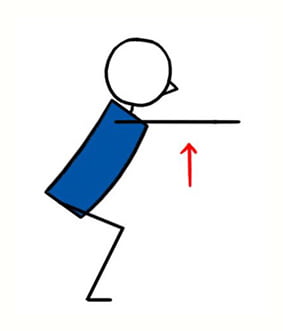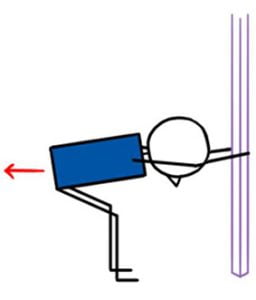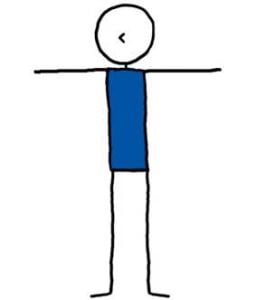
| Category: | Pilates Lesson Planner |
|---|---|
| Sub Category: | |
| Types: | Balance, Hip Opener, Standing, Stretch |
| Anatomy: | Arms & Shoulders, Core, Hamstrings, Hips, Knees, Psoas |
| Chakras: | Base, Heart Centre, Sacral Centre, Solar Plexus Centre |
| Therapy: | Back Pain, Poor Posture, Sciatica |
| Drishti: | Tip Of Nose |
| Dosha: | Kapha, Pitta |
| Meridian Lines: | Stomach |
Stand tall with arms out in front. Feet a little wider than shoulder-width apart. Look straight ahead. Bend at knees and hips into a squat (thighs parallel to floor). Return to start.
Hip opener. Strengthens thighs, buttocks, and hamstrings.
A) Sit on the front edge of a chair. B) Folded blanket under heels. C) Lift all ten toes up. D) Bring arms to tops of legs and reach outward. E) Sit back against a wall like you are in a chair. F) Add a twist. G) Sit on a block. H) Roll a blanket and place it in the crease of both knees.
Knee injury.
Click here for lots of FREE downloadable Yoga lesson plans.
Click here for lots of FREE downloadable Pilates lesson plans.
- Spencer's Lesson Plan
- Sandford week four
- Ask Genie1
- Pilates Improvers - Lesson 1
- Mathwork
- Sandford week one
- 15 Minute Lower Body Challenge
- First
- Matwork Poses
- Vanessa
- matwork
- Week 3
- Easter homework
- Lesson 2
- 29 November 2018
- Lesson 3
- Ask Genie3
- Gluts workout
- Ask Genie2
- Lesson 2
- Ruth
- Diane
- 26 November 2018
- V1 Mixed Level
- Pilates - Class Plan 13
- Beginner/intermediate 2
- June 2018
- Kathryn
- Abigail
- Melanie
- Yvonne
- Jane
- Emily
- Irene
- Holiday treat
- Pilates - Aug/Sept - week 4/6 - all groups (glute focus)
- Glutes
- Boxing
- Bernadette
- Holly
- Virtual Pilates 7
- 26.11.18
- Wobble cushion 2
- Wednesday 9.30
- Newvic 2
- Parados y aro
- Jen
- Anne Day
- Paul 3
- lesson 12
- warm up
- Ask Genie1
- long lesson -- 12?
- U3A Group 1 13/12/19
- Sally
- Beginner Class 18/09/2019
- Assessment
- ARK Pilates October Lesson Plan One
- EVH 28/11/19
- Steve
- Sally Dixon
- Gluts 2
- Moira 2
- Caroline
- Standing Matwork Exercises
- Week 1 (control)
- Mary
- Mat Work 7
- Mary April 2018
- Adele
- Margaret
- Intermediate Pilates May 5th
- Pilates - General May 6/7
- Intermediate Pilates May 11th
- General Pilates May 12/13
- Virtual Pilates 21/05/2020 Intermediate - Corine
- Ideas
- Pilates lesson 10
- Ideas 2
- Pilates wc 1307
- Hip exercises
- 28.7.20
- Anita
- Phil
- Karen Cartwright
- Denise Shield
- Full Body Bands Mixed Ability Lesson Plan
- Reformer Assessment
- Virtual Pilates 21/05/2020 Intermediate - Corine
- General Pilates May 12/13
- General Pilates May 12/13
- pilates beginner 1
- 29 November 2018
- 28.7.20
- Ask Genie1
- Ask Genie1
- Ask Genie3
- Ask Genie3
- Cooke/Lockhart family January
- Ask Genie2
Pilates Squat Pose FAQs
What are other names for Squat Pose?
- Deep squat pose
- Sitting down pose
What’s the most important thing to be aware of in a Squat pose?
Make sure that the knees are pointing in the same direction as your toes.
What should I be aware of when in a Squat pose?
Squat pose challenges will challenge your entire body because it requires mobility and stability in the ankles, knees, hips, pelvis, and spine.
When in the pose silently ask yourself these questions:
- How does it feel?
- Where do I feel it?
- Are my heels lifted (the goal is to have the heels down)?
- Are my ankles rolling in?
- Are my arches collapsed?
- Are my toes turning out excessively (or do they want to)?
- How do my knees look and feel?
- Are my knees collapsing in?
- Is one knee collapsing in more than the other?
- Is one hip closer to the ground?
- Am I leaning to one side?
- Is my spine straight, arched, or rounding forward?
- Is my tailbone tucking under excessively?
If my heels are lifted when in a Squat pose what does that mean?
If your heels are lifted, it usually indicates a limitation in the Achilles tendon and calves. Allow your heels to lift and over time, with regular practice, the heels will lower down to the floor. It may also indicate hamstring tightness, piriformis tightness, or weakness in the gluteus medius. An easy way to make the pose more accessible is to place a rolled-up towel or blanket under the heels for support. If your heels are close to the ground, try widening your feet and turning the toes out.
How wide should my stance be in a Squat pose?
Have fun experimenting with a wide and narrow stance to find the ideal Squat pose width for you. There is no one-size-fits-all.
If my heels are knees collapsed when in a Squat pose what does that mean?
If your knees are collapsed (hips are internally rotated), you may have weak gluteus muscles, tight adductors (inner thighs), or a tight iliotibial band (a band of fascia along the outside of the leg from the hip to the knee).
If my low back is arched excessively when in a Squat pose what does that mean?
If your low back arched excessively, you may have tight hip flexors that are compensating for weak core muscles.
If my spine is rounded forward when in a Squat pose what does that mean?
If your spine is rounded forward, you may have weak erector spinae muscles (iliocostalis, longissimus, and spinalis), a tight thoracic (middle) spine, or tight hamstrings.
If I lean to one side when in a Squat pose what does that mean?
Leaning to one side could mean that you have a stability problem or an asymmetry (two sides that are not the same) of the ankle, knee, or hip.
If one shoulder is higher than the other in a Squat pose what does that mean?
It’s common for the shoulder of our dominant side to be tighter, and less mobile.
What are some modifications to the Squat pose?
A) Sit on the front edge of a chair.
B) Folded blanket under heels.
C) Lift all ten toes up.
D) Bring arms to the tops of legs and reach outward.
E) Sit back against a wall like you are in a chair.
F) Add a twist.
G) Sit on a block.
H) Roll a blanket and place it in the crease of both knees.




 Yoga Lesson Planner
Yoga Lesson Planner
 Pilates Lesson Planner
Pilates Lesson Planner








